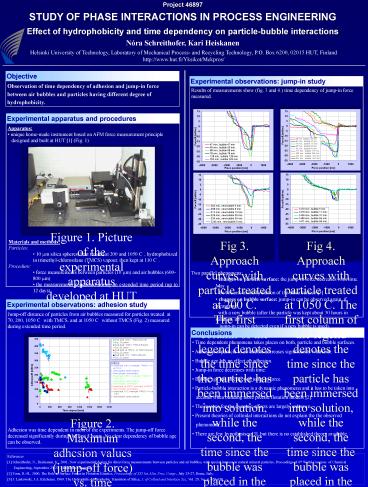STUDY OF PHASE INTERACTIONS IN PROCESS ENGINEERING - PowerPoint PPT Presentation
1 / 1
Title:
STUDY OF PHASE INTERACTIONS IN PROCESS ENGINEERING
Description:
Effect of hydrophobicity and time dependency on particle-bubble interactions ... between air bubbles and particles having different degree of hydrophobicity. ... – PowerPoint PPT presentation
Number of Views:58
Avg rating:3.0/5.0
Title: STUDY OF PHASE INTERACTIONS IN PROCESS ENGINEERING
1
Project 46897
STUDY OF PHASE INTERACTIONS IN PROCESS ENGINEERING
Effect of hydrophobicity and time dependency on
particle-bubble interactions
Nóra Schreithofer, Kari Heiskanen
Helsinki University of Technology, Laboratory of
Mechanical Process- and Recycling Technology,
P.O. Box 6200, 02015 HUT, Finland http//www.hut.f
i/Yksikot/Mekpros/
Objective
Experimental observations jump-in study
Observation of time dependency of adhesion and
jump-in force between air bubbles and particles
having different degree of hydrophobicity.
- Results of measurements show (fig. 3 and 4.) time
dependency of jump-in force measured.
Experimental apparatus and procedures
- Apparatus
- unique home-made instrument based on AFM force
measurement principle - designed and built at HUT 1 (Fig. 1)
- Materials and methods
- Particles
- 10 ?m silica spheres, heat treated at 200 and
1050 C, hydrophobized in trimethyl-chlorosilane
(TMCS) vapour, then kept at 110 C. - Procedure
- force measurements between particles (10 ?m) and
air bubbles (600-800 ?m) - the measurements conducted during an extended
time period (up to 12 days).
Experimental observations adhesion study
Jump-off distance of particles from air bubbles
measured for particles treated at 70, 200, 1050
C with TMCS, and at 1050 C without TMCS (Fig.
2) measured during extended time
period. Adhesion was time
dependent in most of the experiments. The
jump-off force decreased significantly during the
first 5 hours. No clear dependency of bubble age
can be observed.
Conclusions
- Time dependent phenomena takes places on both,
particle and bubble surfaces. - Adhesion of particle to air bubble decreases
significantly with time. - Bubble age has no effect on adhesion.
- Jump-in force decreases with time.
- Bubble age has an effect on jump-in force.
- Particle-bubble interaction is a dynamic
phenomena and it has to be taken into - account when building more precise flotation
models 2. - The reasons for the dynamic effects are largely
unknown. - Present theories of colloidal interactions do
not explain the the observed - phenomena.
- There are few hypothesises 3, but there is no
established theory available.
Figure 2. Maximum adhesion values (jump-off
force) vs. time
References 1 Schreithofer, N., Heiskanen, K.,
2001. New experimental design for direct force
measurements between particles and air bubbles,
with special interest on natural mineral
particles. Proceedings of 6th World Congress of
Chemical Engineering, September 23-27,
Melbourne, Australia. 2 Yoon, R.-H., 2000. The
Role of Surface Forces in Flotation Kinetics,
Proceedings of XXI Int. Min. Proc. Congr., July
23-27, Rome, Italy. 3 J. Laskowski, J.A.
Kitchener, 1969. The Hydrophilic-Hydrophobic
Transition of Silica, J. of Colloid and Interface
Sci., Vol. 29, No. 4, 670-679.






























